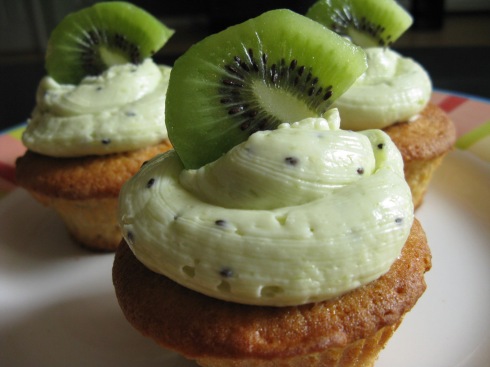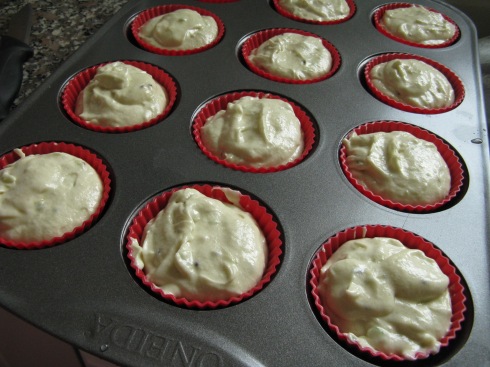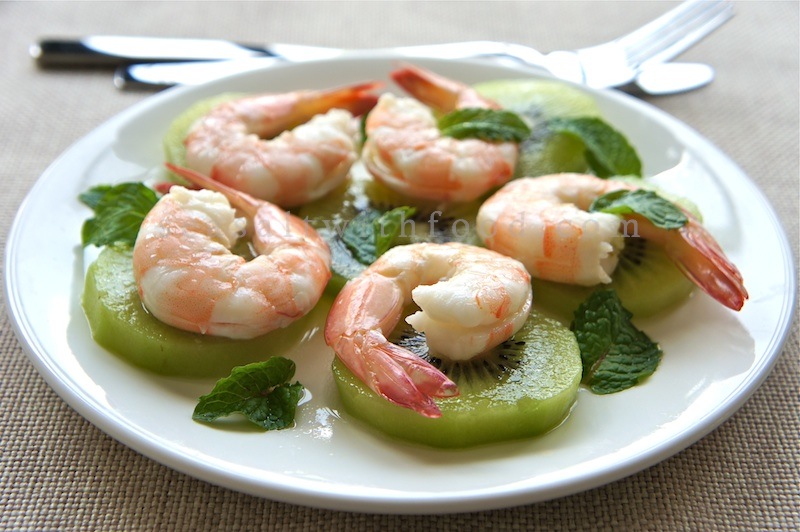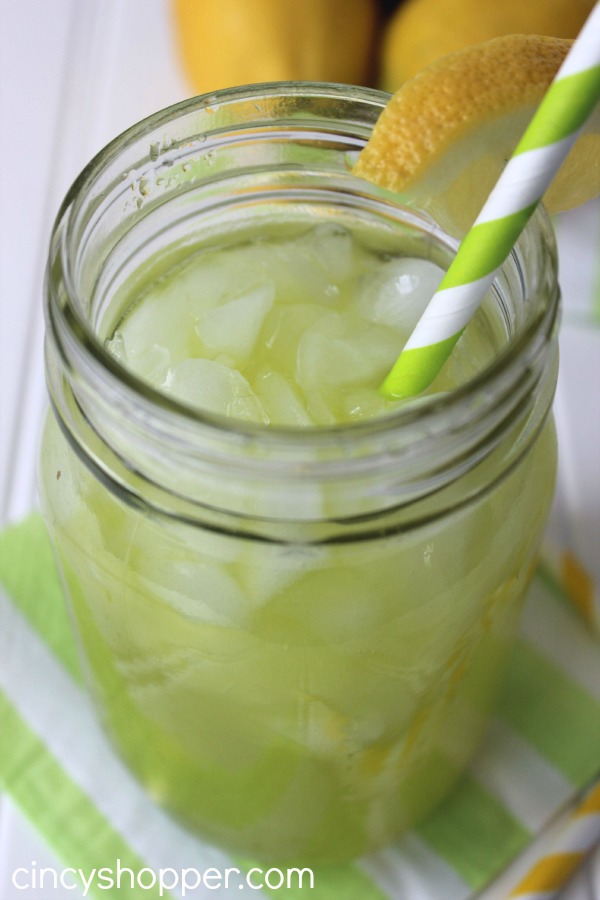sister herb
Official TTI Chef
Let´s talk about kiwi (the fruit, not the bird).
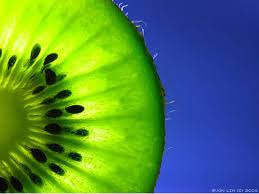
The kiwifruit or Chinese gooseberry (often shortened to kiwi outside New Zealand), is the edible berry of a woody vine in the genus Actinidia.
The most common cultivar group of kiwifruit ('Hayward') is oval, about the size of a large hen's egg (5–8 cm (2.0–3.1 in) in length and 4.5–5.5 cm (1.8–2.2 in) in diameter). It has a fibrous, dull greenish-brown skin and bright green or golden flesh with rows of tiny, black, edible seeds. The fruit has a soft texture and a sweet but unique flavor, and today is a commercial crop in several countries, such as Italy, New Zealand, Chile, Greece, and France.
Kiwifruit is native to northern China. Other species of Actinidia are native to India, Japan, and southeastern Siberia. Cultivation of the fuzzy kiwifruit spread from China in the early 20th century, when seeds were introduced to New Zealand by Mary Isabel Fraser, the principal of Wanganui Girls' College, who had been visiting mission schools in Yichang, China. The seeds were planted in 1906 by a Wanganui nurseryman, Alexander Allison, with the vines first fruiting in 1910.
The first commercial planting of Chinese gooseberries occurred in 1937 in New Zealand by the orchardist Jim MacLoughlin. The fruit proved popular with American servicemen in New Zealand during World War II. In 1952, MacLoughlin partnered with the New Zealand Fruit Federation to market and export the fruit in the United States market. Due to pioneering research into the transportability of the fruit by John Pilkington Hudson and others at the agriculture department in Wellington, this was the first international export of the kiwifruit.
The genus Actinidia contains around 60 species. Though most kiwifruit are easily recognized as kiwifruit (due to basic shape) their fruit is quite variable. The skin of the fruit can vary in size, shape, hairiness, and color. The flesh can vary in color, juiciness, texture, and taste. Some fruits are unpalatable while others taste considerably better than the majority of the commercial varieties.
The most common kiwifruit is the Fuzzy Kiwifruit and comes from the species A. deliciosa. Other species have fruits that are commonly eaten; some examples are Golden Kiwifruit (A. chinensis), Chinese Egg Gooseberry (A. coriacea), Baby Kiwifruit (A. arguta), Arctic Kiwifruit (A. kolomikta), Red Kiwifruit (A. melanandra), Silver Vine (A. polygama), Purple Kiwifruit (A. purpurea).[12]
Fuzzy kiwifruit
Almost all kiwifruit in commerce belong to a few cultivars of fuzzy kiwi (Actinidia deliciosa): 'Hayward', 'Blake', and 'Saanichton 12'. They have a fuzzy, dull-brown skin, and bright-green flesh. The familiar cultivar 'Hayward' was developed by Hayward Wright in Avondale, New Zealand, around 1924. It was initially grown in domestic gardens, but commercial planting began in the 1940s.
'Hayward' is the most commonly available cultivar in stores. It is a large, egg-shaped fruit with a sweet flavor. 'Saanichton 12', from British Columbia, is somewhat more rectangular than 'Hayward' and comparably sweet, but the inner core of the fruit can be tough. 'Blake' can self-pollinate, but it has a smaller, more oval fruit and the flavor is considered inferior.[1][12] The most common male pollenizer for these varietals is 'Chico'.
Golden kiwifruit

A sliced golden kiwifruit
The golden kiwi (Actinidia chinensis) has a smooth, bronze skin, with a beak shape at the stem attachment. Flesh color varies from bright green to a clear, intense yellow. This species is sweeter and more aromatic in flavor; the flavor is reminiscent of some subtropical fruit. Its short storage life currently limits its commercial potential. One of the most attractive varieties has a red 'iris' around the center of the fruit and yellow flesh outside. The yellow fruit fetches a higher market price and, being less hairy than the fuzzy kiwi, is more palatable for consumption without peeling.
A commercially viable variety of this red-ringed kiwi, patented as the EnzaRed, is a cultivar of the Chinese hong yang variety.
Hort16A, marketed as Zespri® Gold, is a golden kiwifruit now marketed worldwide in increasing volumes.
Kiwi berries

The larger fuzzy kiwi in back compared to the smaller kiwi berry
Kiwi berries are composed of three species of kiwifruit, hardy kiwi (Actinidia arguta), Arctic beauty (A. kolomikta), and silver vine (A. polygama). They are fast-growing, climbing vines, durable over their growing season. The fruits are edible berry- or grape-sized fruits similar to the fuzzy kiwi in taste and appearance, with thin, smooth skin. They are referred to as kiwi berry, baby kiwi, dessert kiwi, grape kiwi, or cocktail kiwi.
The cultivar 'Issai' is a hybrid of hardy kiwi and silver vine which can self-pollinate. Grown commercially because of its relatively large fruit, Issai is less hardy than most hardy kiwi.
Allergies
The actinidain found in kiwifruit can be an allergen for some individuals. Specifically, people allergic to latex, bananas, papayas, or pineapples are likely to also be allergic to kiwifruit. The fruit also contains calcium oxalate crystals in the form of raphides. Reactions to these chemicals include sweating, tingling, and sore mouth or throat; swelling of the lips, tongue and face; rash; vomiting and abdominal pain, heartburn; and, in the most severe cases, breathing difficulties, wheezing, and collapse. The most common symptoms are unpleasant itching and soreness of the mouth, with the most common severe symptom being wheezing. Severe symptoms are most likely to occur in young children.
The kiwifruit or Chinese gooseberry (often shortened to kiwi outside New Zealand), is the edible berry of a woody vine in the genus Actinidia.
The most common cultivar group of kiwifruit ('Hayward') is oval, about the size of a large hen's egg (5–8 cm (2.0–3.1 in) in length and 4.5–5.5 cm (1.8–2.2 in) in diameter). It has a fibrous, dull greenish-brown skin and bright green or golden flesh with rows of tiny, black, edible seeds. The fruit has a soft texture and a sweet but unique flavor, and today is a commercial crop in several countries, such as Italy, New Zealand, Chile, Greece, and France.
Kiwifruit is native to northern China. Other species of Actinidia are native to India, Japan, and southeastern Siberia. Cultivation of the fuzzy kiwifruit spread from China in the early 20th century, when seeds were introduced to New Zealand by Mary Isabel Fraser, the principal of Wanganui Girls' College, who had been visiting mission schools in Yichang, China. The seeds were planted in 1906 by a Wanganui nurseryman, Alexander Allison, with the vines first fruiting in 1910.
The first commercial planting of Chinese gooseberries occurred in 1937 in New Zealand by the orchardist Jim MacLoughlin. The fruit proved popular with American servicemen in New Zealand during World War II. In 1952, MacLoughlin partnered with the New Zealand Fruit Federation to market and export the fruit in the United States market. Due to pioneering research into the transportability of the fruit by John Pilkington Hudson and others at the agriculture department in Wellington, this was the first international export of the kiwifruit.
The genus Actinidia contains around 60 species. Though most kiwifruit are easily recognized as kiwifruit (due to basic shape) their fruit is quite variable. The skin of the fruit can vary in size, shape, hairiness, and color. The flesh can vary in color, juiciness, texture, and taste. Some fruits are unpalatable while others taste considerably better than the majority of the commercial varieties.
The most common kiwifruit is the Fuzzy Kiwifruit and comes from the species A. deliciosa. Other species have fruits that are commonly eaten; some examples are Golden Kiwifruit (A. chinensis), Chinese Egg Gooseberry (A. coriacea), Baby Kiwifruit (A. arguta), Arctic Kiwifruit (A. kolomikta), Red Kiwifruit (A. melanandra), Silver Vine (A. polygama), Purple Kiwifruit (A. purpurea).[12]
Fuzzy kiwifruit
Almost all kiwifruit in commerce belong to a few cultivars of fuzzy kiwi (Actinidia deliciosa): 'Hayward', 'Blake', and 'Saanichton 12'. They have a fuzzy, dull-brown skin, and bright-green flesh. The familiar cultivar 'Hayward' was developed by Hayward Wright in Avondale, New Zealand, around 1924. It was initially grown in domestic gardens, but commercial planting began in the 1940s.
'Hayward' is the most commonly available cultivar in stores. It is a large, egg-shaped fruit with a sweet flavor. 'Saanichton 12', from British Columbia, is somewhat more rectangular than 'Hayward' and comparably sweet, but the inner core of the fruit can be tough. 'Blake' can self-pollinate, but it has a smaller, more oval fruit and the flavor is considered inferior.[1][12] The most common male pollenizer for these varietals is 'Chico'.
Golden kiwifruit

A sliced golden kiwifruit
The golden kiwi (Actinidia chinensis) has a smooth, bronze skin, with a beak shape at the stem attachment. Flesh color varies from bright green to a clear, intense yellow. This species is sweeter and more aromatic in flavor; the flavor is reminiscent of some subtropical fruit. Its short storage life currently limits its commercial potential. One of the most attractive varieties has a red 'iris' around the center of the fruit and yellow flesh outside. The yellow fruit fetches a higher market price and, being less hairy than the fuzzy kiwi, is more palatable for consumption without peeling.
A commercially viable variety of this red-ringed kiwi, patented as the EnzaRed, is a cultivar of the Chinese hong yang variety.
Hort16A, marketed as Zespri® Gold, is a golden kiwifruit now marketed worldwide in increasing volumes.
Kiwi berries

The larger fuzzy kiwi in back compared to the smaller kiwi berry
Kiwi berries are composed of three species of kiwifruit, hardy kiwi (Actinidia arguta), Arctic beauty (A. kolomikta), and silver vine (A. polygama). They are fast-growing, climbing vines, durable over their growing season. The fruits are edible berry- or grape-sized fruits similar to the fuzzy kiwi in taste and appearance, with thin, smooth skin. They are referred to as kiwi berry, baby kiwi, dessert kiwi, grape kiwi, or cocktail kiwi.
The cultivar 'Issai' is a hybrid of hardy kiwi and silver vine which can self-pollinate. Grown commercially because of its relatively large fruit, Issai is less hardy than most hardy kiwi.
Allergies
The actinidain found in kiwifruit can be an allergen for some individuals. Specifically, people allergic to latex, bananas, papayas, or pineapples are likely to also be allergic to kiwifruit. The fruit also contains calcium oxalate crystals in the form of raphides. Reactions to these chemicals include sweating, tingling, and sore mouth or throat; swelling of the lips, tongue and face; rash; vomiting and abdominal pain, heartburn; and, in the most severe cases, breathing difficulties, wheezing, and collapse. The most common symptoms are unpleasant itching and soreness of the mouth, with the most common severe symptom being wheezing. Severe symptoms are most likely to occur in young children.


